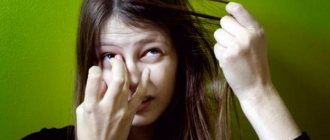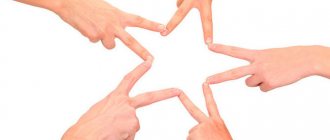What is dermatillomania and how does it manifest?
Experts call dermatillomania obsessive behavior aimed at the skin: scratching wounds, squeezing out inflammations, combing uneven skin, picking off hangnails, biting the lips and cheeks from the inside.
There are actually many more such examples - they all belong to a large group of body-focused repetitive behavior disorders (BFRB - body-focused repetitive behavior). Along with dermatillomania, it also includes trichotillomania (uncontrolled hair pulling), onychophagia (obsessive biting of nails and cuticles), rhinotillexomania (the need to pick the nose and damage its mucous membrane).
With dermatillomania, open areas of the body most often suffer, or rather, those to which there is direct access - the face, head, hands. But it also happens that a person injures his back, chest, and the front of his legs.
How does dermatillomania manifest?
How do you know if you are one of the people who suffer from dermatillomania? Each of us, more than once in our lives, has squeezed out a pimple that has popped up on our face or picked out a healing wound on the skin with our fingernail. When is such action normal, and when to plan a trip to the doctor?
Analyze your behavior.
- How often do you injure yourself like this?
- How long does it take you to do these “procedures”?
- What causes your desire to comb or scratch an old wound?
- Are your actions causing visible damage? Infections? Scars?
- And the most important question: does damage to your skin affect the activity of your communication with other people?
If you try to constantly hide your scars with makeup, if you refuse to wear revealing clothes, if you avoid crowds of people who can see your injuries, then the problem is not only there, it’s time to solve it.
Dermatillomania has a psychological basis, this disorder is similar to neurotic excoriations, but there are no standard symptoms - they can vary from person to person. That’s why experts believe that there are many more people with such problems: many potential patients do not seek help. Dermatillomania is now classified as a symptom of obsessive-compulsive disorder.
The psychological causes of the disease may be hidden deep in the patient's mind. They may be:
- suppressed feelings of anger and disappointment;
- feelings of self-deprecation and shame;
- feeling of guilt;
- clinical depression;
- chronic stress of long duration.
Dermatillomania does not appear out of nowhere. Yes, its cause often lies in the psychological state of the patient, but its predecessor is usually some skin disease or other problem of a cosmetic nature. Those at risk are those who have manifestations of skin diseases on exposed areas of the body, as well as patients suffering from rashes with severe itching.
The process of developing dermatillomania usually begins with a mirror.
Patient looking at himself
mirror, sees some minor manifestations on the skin and begins to suspect that it is something serious. In fact, it can be ordinary pimples or acne. But they make him nervous, and constant irritation leads to the fact that all the patient’s attention is focused on these pimples. They can’t distract themselves from them, so they squeeze them out over and over again, damaging their skin more and more. At the same time, some may comb injuries on the face or other open part of the body over and over again, simply because they cannot accept that everyone sees this place, while others comb injuries on the scalp, since they are hidden by hair and, on the contrary, no one does not see. Over time, the scars spread further and further - to the arms, legs, shoulders, back, as the person simply cannot control his desire to scratch the rashes that appear.
Dermatillomania and perfectionism
The fact that people most often focus on exposed areas of the body has led researchers to believe that dermatillomania is triggered by the desire to achieve an ideal appearance (for example, to eliminate a certain “flaw”). As a result, comprehensive skin care can take on inadequate forms over time.
Ira Polevaya blogs about dermatillomania on Instagram. She has lived with the disorder for eight years and associates its appearance in adolescence with the attitudes of “ideality” that were broadcast by fashion glossy:
“When I was 10 years old, I started collecting women’s teen magazines, where all the models are presented with perfect retouched skin. So a strange attitude arose in my head: “I must have perfect skin, otherwise there is no other way.” To me, it felt like a vital commitment, like knowing how to breathe.
But at the age of 12, as luck would have it, I started getting small rashes on my face, and it knocked me off my feet. I decided to get rid of these “imperfections” on my own: I crushed them and pierced them. At the same time, I tried to treat my skin the normal way, but the sight of an unpopped pimple forced me to resort to the old “bloody methods.” This dragged on for 8 years. At 17, an exacerbation began: I picked my cheek very badly, a large pink spot remained, and I began to fear that it would always be like this. This means that I will never be able to get closer to a non-existent ideal.”
Other girls also agree with the idea that beauty culture, Instagram fetishes, lookism and other stereotypes around appearance can influence the development of dermatillomania in adolescents:
“Photoshopped photos can create the erroneous impression that everyone around you has perfect skin without flaws,” says Yulia.
But the idealized image of skin in popular culture is just the tip of the iceberg. Researchers believe that the causes of dermatillomania lie deeper and have an individual background: the special biological sensitivity of the nervous system and anxiety that arises in childhood.
How does dermatillomania occur?
What is dermatillomania
➤ Dermatillomania begins for many reasons. For many patients, skin picking first began with the onset of acne during adolescence. Acne is picked, scratched and squeezed. The compulsion to scratch and pick at the skin continues even after the acne disappears. Other types of skin conditions may act as the onset of dermatillomania. These commonly include keratosis pilaris, psoriasis and eczema. It is important to note that skin care for skin with these conditions can be adequately normal. However, people with dermatillomania tend to over-groom their skin. The amount of skin care is disproportionate to the severity of the skin condition. Whether skin picking is caused by acne or another skin condition, in most cases these symptoms first occur in teenagers. But dermatillomania also usually first appears in adults. Another common age range is from 30 to 45 years. Onset at this age can occur for the same reasons: acne and other skin diseases. It is also associated with stressful life events. These include family conflicts, death of friends or family, and unwanted pregnancy. Because skin picking is associated with obsessive-compulsive disorder (OCD), its onset can often be associated with the onset of other OCD symptoms. One recent study of patients with dermatillomania found that more than 47.5% of those surveyed began exhibiting this skin-picking behavior before age 10.
Dermatillomania and anxiety
The American Psychiatric Association considers dermatillomania within the framework of obsessive-compulsive disorder (OCD). The term “neurotic excoriation” is used, that is, uncontrolled scratching.
The consciousness of a person with OCD is guided by a closed chain “restless thought - anxious expectation - fear - habitual ritual - relief”:
- The thought of imperfection fuels a chronic anxiety background, in which it is unbearable to constantly exist.
- A person again and again resorts to a familiar ritual, because he sees this as the only way to at least temporarily get rid of painful anxiety.
- And the usual ritual here is bodily obsession: only after exposure to the skin does the stage of temporary relief and internal satisfaction begin.
- Then discomfort inevitably increases again, dissatisfaction with the condition of the skin arises - the chain closes and everything happens again.
Manipulations lead to the desired relaxation, but not for long: anxiety subsides only for a while, and feelings of guilt and shame for one’s own “weakness” and loss of control are overwhelming.
“When you pick, you forget. Afterwards the relief will not last long. And when you look at the spotty face afterwards, you ask, “Why again?” After all, you could just not pick,” and it became sad to look at yourself in the mirror” (Ilona, 24 years old).
The girl says that she often gets hung up on negative thoughts:
“Usually this happens if I’m driven for some reason. Or after a quarrel with someone, I may feel somewhat inferior. On nerves, so to speak."
Ulyana Kardashevskaya (18 years old) also associates dermatillomania with increased anxiety:
“For me, this usually happens after a difficult day or, conversely, before some important event. You walk up to the mirror, think you’ll just look, and don’t notice how your fingers have already noticed an unevenness on the skin. I think a difficult relationship with my mother, my low self-esteem and high anxiety played a role here.”
Dermatillomania – self-harming behavior
It may seem incredible, but the habit of squeezing pimples or chewing hangnails can turn into a tragedy - dermatillomania. Dermatillomania is a psychological behavioral disorder that is literally reflected and even imprinted on the skin, since its manifestations include constant compulsive scratching and scratching of the skin.
Dermatillomania - an obsessive condition 49233
Dermatillomania - behavior disorder
Dermatillomania is a psychological disorder, the course of which is very similar to neurotic excoriations, although its nature is very closely related to another disorder - dysmorphophobia. This is a fairly rare condition, so its definition and symptoms vary, although, however, experts believe that the incidence statistics of dermatillomania are much higher - such patients simply rarely seek help. Recently, dermatillomania has been included in the spectrum of symptoms of obsessive-compulsive disorder (OCD): in the latest fifth version of the DSM (Diagnostic and Statistical Manual of Mental Disorders), the “bible of psychiatrists” around the world, this disease is classified as a variant of OCD. However, dermatillomania and obsessive-compulsive disorder have perhaps only one thing in common - obsessive repetitive behavior. Opponents of this classification believe that dermatillomania is still more like an addiction than an obsessive condition.
This disease hides deep psychological reasons that in some unknown way force a person to scratch his skin again and again. Many psychological causes of dermatillomania lie in suppressed feelings - anger, disappointment. However, most often the disease is provoked by such common “complexes” as self-abasement, guilt or shame. Often, dermatillomania is a consequence of an anxiety disorder or clinical depression. Sometimes dermatillomania is triggered by significant acute or prolonged chronic stress.
Typically, dermatillomania does not develop simply because of internal “negativity” - it is often preceded or facilitated by skin diseases or simply cosmetic problems, especially those that appear on open areas of the body. The risk of developing this disorder is high in people suffering from itchy rashes: they are more likely to form an “itchy” stereotype.
This disorder, which is a consequence of negative feelings, can itself also lead to troubles in daily and social life, although some people suffering from dermatillomania manage to successfully hide its symptoms and traces for a long time.
How does dermatillomania develop?
This pathology is purely a behavioral disorder, although, as with body dysmorphic disorder, it all starts with the mirror. At first, as a rule, noticing the first minor manifestations on the skin, say, acne, a person begins to suspect that he is suffering from something more serious (although in fact this is not the case). This unnerves him, constantly irritates him, he fixates on an imaginary illness, cannot distract himself from the pimple - and as a result, he scratches his skin repeatedly and uncontrollably. The circumstances surrounding the development of dermatillomania may vary from person to person: some may become enraged by acne, while others will get carried away with scratching a small injury on the scalp, believing that the damage will not be noticeable to strangers.
Scratching and accompanying scars can spread to one or more areas of the body: the face, scalp, neck and décolleté. Scratching appears somewhat less frequently on more covered parts of the body, such as shoulders, armpits, back, arms and legs.
Symptoms of dermatillomania
A characteristic symptom: people with dermatillomania experience a short-term feeling of relief and even pleasure when scraping or scratching. Soon the stress peak comes again, which again gives way to a feeling of relief or pleasure when you manage to successfully pick off a crust on the skin or squeeze out a pimple... The cycle is repeated countless times, so it is not surprising that the skin becomes covered with scars and scars.
The urge to scratch - a kind of self-injurious impulses - can happen at any time of the day and in any place (even in a public and very crowded place), since they are not controllable. Of course, most often they happen in front of a mirror, but it is not uncommon for such a need to occur while walking, traveling on public transport, at work, while watching TV, reading... Usually attacks last for several minutes and are repeated several times a day. However, in severe cases, attacks of scratching can last up to an hour or more, repeating day after day.
The leading symptom of dermatillomania is compulsive scratching. 45819
The process of “cleansing” your skin is triggered by certain emotional states – most often anxiety, boredom, excitement or fear. The mechanics of the attack are similar to behavioral addiction. The trigger (triggering moment) can be not only the condition described above, but also one’s own appearance, especially if a person begins to look at his skin closely enough. Often people can hear an inner voice belonging to parents or peers that tells them something unpleasant about their skin condition. There is a narrowing of attention and a state of mild excitement. When the “violator” of skin smoothness is eliminated, pus or other contents are released from its cavity, the person experiences pleasure and relaxation. Then he moves away from the mirror and sees red or bleeding skin, or after some time he discovers that the infection has spread and he is overcome with a feeling of shame for his lack of ability to control himself. Thoughts appear that friends and relatives will again see traces of his weakness, will reproach him or simply “think badly of him.” Shame, as an intense negative experience, already prepares the ground for the next attack on oneself.
Dermatillomania may be accompanied by other symptoms also associated with obsessive repetitive behavior: the habit of biting nails, tearing or biting hangnails and cuticles, the habit of biting lips or the skin inside the cheek, pulling out hair (it is classified as a separate disorder - trichotillomania). One way or another, a person is irresistibly drawn to pick a scab, despite the fact that he knows that this can cause harm, and his action may be followed by bleeding or a scar will remain - but he still continues his manipulations. These impulses cannot be controlled because they are irrational, so it is almost impossible to get rid of dermatillomania after another attack without special treatment: few people manage to avoid frequent repetition of scratching “rituals” using willpower alone.
Treatment of dermatillomania
This disease often requires the intervention of not only a psychotherapist, but also a professional dermatologist. It is very important to correctly establish the diagnosis, because this pathology is still poorly understood and requires serious support from a medical specialist (psychotherapist or psychiatrist; psychologists will not be able to help with such disorders). Treatment of dermatillomania is carried out using various techniques, so-called talking therapy. Cognitive behavioral psychotherapy brings good results.
Yoga, meditation, various relaxation techniques, sports, and in general any activity that brings positive emotions can also be of great help. Therefore, experts recommend that such people acquire a couple of hobbies. Medicines (mostly antidepressants) are prescribed if depression is diagnosed, and dermatillomania has developed precisely against its background. However, among other things, such drugs can still be useful in severe cases of this disorder (with prolonged attacks of scratching, their high frequency, etc.).
Intrusive skin trauma and hair pulling 46117
Since attacks of dermatillomania occur against the background of a narrowed consciousness and are poorly or almost not realized, for this reason it is recommended to avoid the main triggers, including:
- View of your own skin from a close distance: it is not recommended to come close to the mirror or even avoid contemplating your own reflection, reducing “communication” with this object to the very minimum.
- Often an attack can be triggered not only after looking at oneself, but also after feeling the skin. In such cases, it is recommended to stick a patch or pieces of tape on the fingertips - when the hand touches the face or other “problem” areas of the skin, the consciousness will register this fact.
- Stressful situations: this rule is quite difficult to follow, since no one is immune from unpleasant surprises, but yoga and meditation really strengthen your nerves in the best sense of the word.
It is not necessary that the habit of scratching the skin and picking off scabs is associated with this disease: only a doctor can make a diagnosis. However, if you're worried that you won't be able to overcome this harmful pattern on your own, see a therapist and find out if you have dermatillomania or similar disorders that are closely related to obsessive-compulsive disorder and body dysmorphic disorder. Such problems are very difficult to solve on your own, so it is better not to hesitate to seek advice from a specialist. If you think that you probably have this particular disease, then you should immediately, urgently seek help: such a disorder does not go away on its own, it is associated with deeper psychological problems, for the solution of which you will need the help of a qualified psychotherapist. It is also recommended to consult a dermatologist to minimize the consequences of the disease - scars and cicatrices.
Dermatillomania as a way to survive violence
Nastya Simbirskaya also writes a blog about dermatillomania, in which she openly talks about the disorder. Its first manifestations occurred at the age of 6 years. According to the girl, in 20 years of living with dermatillomania, there was not a day when she did not touch her skin.
“This happened after my stepfather beat me for the first time. From that moment on, the punishments were regular; I could only distract myself by picking at my skin. And I began to understand that this was already a disease almost 20 years later. I thought I was the only one who was crazy.”
Psychoanalysts talk most about the relationship between skin diseases and traumatic memories from childhood.
According to their observations, the psyche of an adult is capable of regressing - returning to early childhood in order to act out the trauma that occurred not through the child’s fault, but which is still preserved in his unconscious.
And the younger the child, the more physical or emotional abuse will be imprinted on him. The psyche will not record actual memories, but bodily sensations and marks on the skin will remain for life.
“Since for me it is associated with domestic violence and with all the accompanying feelings during the 12 years that I was beaten, now I feel dermatillomania as a way to get rid of obsessive thoughts, emotional swings, fears, stress and suffering. The brain knows no other way to deal with these problems. It’s more convenient for him to cause himself physical pain than to experience psychological pain,” Nastya shares.
How to understand that it is dermatillomania?
The line between self-care and obsessiveness lies where the behavior begins to cause significant inconvenience and suffering, and interfere with daily life.
“I know that it is relatively “normal” to pick off pimples and sores, but it is absolutely not normal to rip off the skin under your nails so that it does not heal for 4 years. It's not normal to stand in front of a mirror for 10, 20, 30 minutes and pick at your skin. It's not normal if your cuticles are damaged because you're picking off every hangnail. It’s not normal if you start bleeding because you’ve torn off too deep a layer of skin.”
- says Alaura.
Dermatillomania always begins “innocently” and with minor injuries. Only when it becomes very difficult to stop and the body turns into a mess strewn with unhealing wounds, it can no longer be ignored.
⠀
Dermatillomania and the need to hurt oneself
Because dermatillomania affects the skin, the disorder is often associated with self-harm and the desire to intentionally hurt oneself. But in fact, the mechanisms of these two conditions are different.
Unlike self-harm, when a person intentionally causes physical pain to himself (for example, to cope with unbearable mental pain), dermatillomania cannot be controlled by the notorious “willpower.”
A person can cause harm to his own skin in a dream or, in the process, plunge into a kind of hypnotic trance and only then see with horror the result of his actions.
Elina Plance (20 years old) began to resort to self-harm after severe stress and quarrels in the family:
“I didn’t think about what was happening then. Now I understand that it was a cry for help due to broken communication with my parents. Alas, an unheard cry. This process distracted from feelings. I switched my attention from internal pain to external pain. This made me feel better. And from the feeling of punishment too.”
According to her, this happens consciously:
“It seems to me that I can even control it, but I don’t want to. In case of a breakdown, I emotionally go wildly destructive and do not want to save myself or feel sorry for myself. Well, emotion is followed by auto-aggressive behavior.”
Symptoms of dermatillomania
The disease occurs in several stages:
- Having noticed some kind of flaw on the skin, the patient experiences excitement and anticipation of the squeezing process.
- The process of excoriation is accompanied by a feeling of fear, shame, and liberation.
- After the manipulation, a feeling of relief comes, for some - pleasure, which lasts for a short time.
- The patient subconsciously looks for a new flaw that needs to be “eliminated,” after which she begins to self-harm with renewed energy.
The process is cyclical, excoriation is repeated several times a day. The urge can occur at any time of the day, anywhere.
Self-harm is usually exposed to exposed skin areas - the face, neck, hands as a demonstration of self-flagellation. In other cases, the scalp is excoriated (the results are hidden from prying eyes, the patient experiences shame and remorse). Driven by these feelings, patients try to cover up the “traces of the crime” with clothes, hair, and cream.
Often shame and horror from what has been done comes immediately after the manipulation. To punish herself, the patient begins to tear the skin again and again. They pull out and scrape off freckles, moles, acne spots, imaginary blemishes, and squeeze out pimples. The tools are nail clippers, scissors, and tweezers. In their absence, nails and teeth are used.
After manipulation, ulcers, wounds, and scars remain on the skin, which do not heal for a long time, as they begin to pick at them again and again. If an infection occurs, generalized inflammation, including sepsis, is possible.
Dermatillomania and fear of judgment
An important diagnostic criterion for dermatillomania is preoccupation with causing damage. A person experiences a mixture of negative feelings towards himself (pity, shame, disgust, disappointment) due to the fact that he has lost control. Promises that this was the last time, that this will not happen again, are often not fulfilled - and the person is ashamed of his weakness, considers himself weak-willed.
As Nastya talks about it:
“Yes, at first the process is satisfying. But as soon as your consciousness returns and you see the result of your actions, a feeling of self-loathing, pity, powerlessness, apathy not only towards yourself, but also towards everything around you arises, aggression.”
Traces of dermatillomania - wounds and scars - provoke avoidance behavior and increase feelings of shame. A person in this state may withdraw, avoid public places, and experience difficulties in his personal life, work and friendships.
“With my brain, I understand that these [inflammations and traces of them] are trifles and people don’t care at all. They saw and forgot. But my sense of comfort does not allow me to take this calmly. I feel complex, I can’t leave the house without makeup,” Nastya shares.
“I know that they DO NOT CARE about my skin, but I still get stressed and feel awkward if a stranger is close and can easily see all my “imperfections,” says Ira Polevaya.
Ask a psychologist a question for free
How to get rid of dermatillomania?Hello. I recently found out that my bad “habit” is called dermatillomania (I used to think that this was just my abnormal property and behavior).
This is not my only problem, but now it is hitting me with renewed vigor. I am 33 years old and have had skin problems since birth. At first I was diagnosed with diathesis, later with neurodermatitis, and that’s how it remains with me to this day. The skin that suffers the most is the face, scalp, shoulders, forearms, and chest, as well as the legs.
At the moment, the skin in these places (especially the arms from the shoulders to the wrists) is just a bunch of small scars. In the summer, under the sun, your hands become patterned with small polka dots, because scars do not tan. In addition to healed scars, there are always sores and small pimples that heal in some places and appear in others, so they are always there.
Due to many years of problems, my skin is thick and rough, uneven, sometimes dry and flaky, sometimes oily and... flaky. But what worries me primarily is not the aesthetic side of the issue (although this is also important), but the fact that I cannot stop and constantly pick at these wounds.
If an ordinary person can itch and that’s it, or even, say, squeeze out a pimple and calm down, then this is not about me. If I start itching or picking at sores, then to stop, I have to make a direct effort of will. Finding and picking out sores for me, one might say, is not a single act, but rather a process. This activity has long become a “background” for thinking, even for watching videos or movies, etc.
Of course, I don’t do this publicly, I try to do it only alone (this is difficult, especially when I’m at home with the children, and even if I myself may not notice how I do it “automatically,” they probably notice).
Since childhood, I have been treating my skin - from natural remedies to hormonal ones, from diet to cleansing the body with all kinds of means. But the reason is obviously in the head, because even skin that has healed after hormonal ointments returns to its current state within a couple of weeks.
But the most shameful thing about my case of mania is that everything that is picked off the skin, I... eat.
I roughly assume that this began in childhood after the most severe form of my illness. I was 11-12 years old, and neurodermatitis was accompanied by an infection. All problem areas of the skin became abscesses, and in general it all came down to the fact that approximately 50% of my skin was a crust, under which there was pus. As soon as I bent my arm at the elbow, for example, the crust cracked and pus simply splashed out in all directions. It was torture for the whole family. This happened not because they didn’t take care of me (I have an overprotective mother, she provided literally sterile conditions for me), the circumstances just happened - the only dermatologist in the city at that time advised removing the pus and cauterizing everything with fucorcin (it’s like brilliant green , only red). Since the affected area was very large, the “cleaning” process was painful, I don’t even know who suffered more from this, me or my mother, who had to do it, and since all this nonsense itched badly, my mother, out of despair, tied me up at night hands like mittens made from sheets so that I don’t itch. I still unwound them and tore off the crusts from the sores, and apparently, so that my mother would not see the crusts, I began to eat them. And in the future, I was very afraid that my mother would find the crusts and scold me that I was itching, so I always ate them. Then I spent a month in a regional clinic (by the way, they said that all our previous treatment and torment was a waste of time) everything healed on hormonal drugs, but still the most common words in our house for a very long time were “don’t itch” and “don’t scratch”, both before and after this story.
In fact, I haven’t thought about this story for many years, just now, trying to analyze where I got such a stupid “childish” habit, I thought that it “grew” from about there, but I feel very uncomfortable because I , I’m already an adult, I can’t get rid of it.
I don’t want my children to see this, I hide the habit from my husband, and in general, I don’t think it’s normal.
I notice that when I look in the mirror, I don't look at myself, but immediately focus on my skin. And what’s the crappiest thing is that I understand that this nonsense eats up a lot of time! For me, this is the most severe type of procrastination of all. I ruin relationships with people because I don’t deliver on what I promised on time because I’m stuck doing it, and then I beat myself up for it, triggering a new wave of addiction. I scold myself for not being able to stop doing this, for the fact that it turns out to be more important to me than keeping my promise, etc. Although, in essence, I really like to help, to do something for people, to see that they like the result of my work, to receive praise (well, everyone loves that), and, of course, payment. Why I “exchange” praise and money for such mockery of myself, both physical and moral, I don’t know, and I don’t know how to get out of this stupid circle.
I would be very grateful for your vision of the situation, support and advice.
Dermatillomania and stigma
People with dermatillomania tend to deny the disorder to the last minute and attribute bodily obsession to a bad habit.
Advertising with photoshopped skin, taboo topics in the media, presenting information in such a way that it appears as if the person himself and his insufficient efforts to care for himself are to blame for imperfect skin - all this only pushes people to compulsively seek out and eradicate their “shortcomings.”
Elina Planze:
“Standards are a very narrow framework that not everyone fits into. Hence a lot of complexes, dislike and self-hatred. If a person is prone to this kind of behavior, all of the above can seriously undermine him. And in order to find relief, a person may resort to self-harm.”
Having imperfect skin is supposedly “unacceptable” from the point of view of beauty standards. Difference and dissimilarity from the person on the cover/screen/banner are unconsciously perceived as rejection in the social environment. You are different = you are a stranger. This can cause a lot of anxiety.
“I believe that the media should show different faces and bodies more often so that people do not strive for a non-existent ideal. When you see photoshopped skin, it seems that if you squeeze out a pimple, you will get the same one, but in reality you get a scar,” says Ulyana Kardashevskaya.
Dermatillomania is stigmatized, and it is shame that causes a person to remain silent and not seek help. It is difficult to explain to others (and most importantly, to oneself) why it is so difficult to control the obsessive desire to harm oneself.
Keeping the problem under wraps creates the perception that the disorder is rare. But, according to research, about 5% of people feel the need to harm their skin in one way or another, and this is one in twenty. It has been found that 3/4 of those who experience dermatillomania are women.
A loved one of mine has dermatillomania. What should I do?
Dermatillomania is destructive impulses, cravings that are difficult to resist. It is important to understand this and not shame a person with dermatillomania for their habit. Shame accompanies your loved one throughout their life. Delicacy and good manners in this matter are the main thing that will help in communication.
“Just stop doing this,” “Pull yourself together,” “Stop being weak (weak)” are not phrases that will help your loved one heal. “To everyone who is telling me to stop, I want to respond: I know what you mean, but believe me, this problem will not go away if you just tell me to stop. I appreciate your intentions, but I feel like I failed again,” says Alaura. Instead, the girl asks for something to occupy her hands (if the desire to damage the skin cannot be controlled even in a public place).
“How can I help you?”, “Let’s think together why you want to harm yourself?”, “What can be done instead?” - these questions, spoken in a calm, friendly tone, will relieve tension and distract a person with dermatillomania.
It is important for people with dermatillomania to know the following:
- it is surmountable;
- Having a disorder is not a shame, but you need to seek help;
- silence only stigmatizes the disorder;
- you are not alone, there are many of us.
The disorder itself or its result (scars, poorly healing wounds, lesions on the skin) does not make you worse. You can help yourself if you ask for help. You can improve your life.
How to help yourself with dermatillomania?
Dermatillomania is a reflection of internal problems, suppressed anxiety, aggression and a range of other emotions. It is pointless to treat only visible manifestations (damage or scars) if the behavior remains unchanged and the person will resort to the same way of responding every time.
It can be difficult to notice obsessive behavior, especially when it brings illusory comfort and is perceived as the only chance to cope with difficult emotions. But recognizing the disorder is the first and important step.
“I first learned about dermatillomania from the book “The Skin We Live In.” I was very surprised that this was a disease, and not just a bad habit,” recalls Inna (25 years old).
“Overcoming” the disorder in the usual sense will not work—the symptom cannot simply be removed from your head, like an annoying app on your iPhone. But it is quite possible to work with the disorder and find out what is hidden behind self-harmful behavior.
Some psychotherapeutic techniques have proven their effectiveness in the treatment of dermatillomania, for example, the dialectical behavioral approach or the habit reversal therapy method, borrowed from cognitive behavioral therapy.
How would people with dermatillomania want to be treated?
Environmental support is an important factor in dealing with any disorder. Dermatillomania has always been a taboo topic: it is not so easy in the era of eternal improvement and striving for the ideal to admit one’s imperfection.
“I would like at least someone to care what happens to me. So that close people who would notice that I have problems would try to find a solution with me (for example, support me in finding a psychotherapist). At the same time, I can’t blame those who think it’s just a bad habit. I myself once thought so, because little attention is paid to this disorder,” shares Inna.










